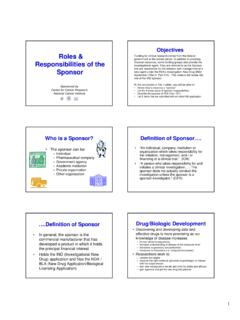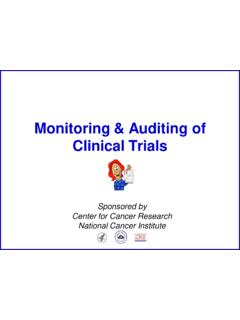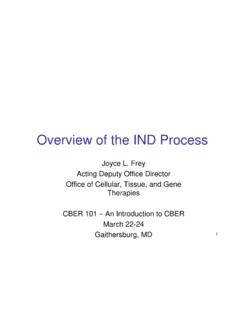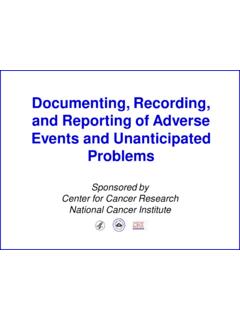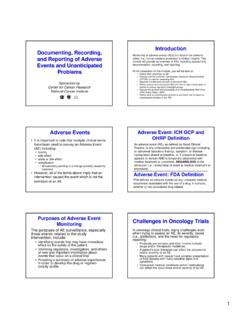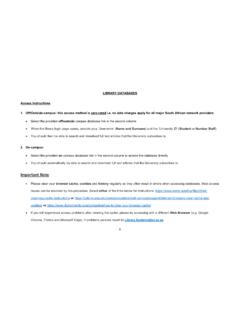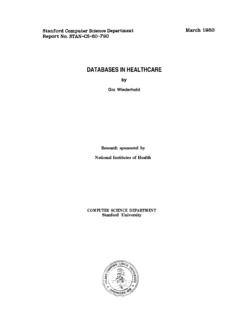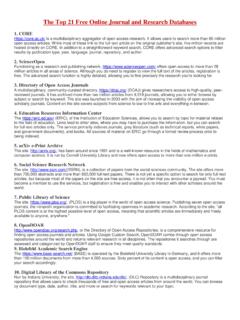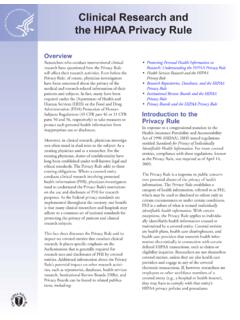Transcription of Clinical Data Management - Center for Cancer Research
1 Sponsored by Center for Cancer Research National Cancer Institute Clinical data Management Introduction Clinical data Management (CDM) consists of various activities involving the handling of data or information that is outlined in the protocol to be collected/analyzed. CDM is a multidisciplinary activity. This module will provide an overview of Clinical data Management and introduce the CCR s Clinical Research database. By the end of this module, the participant will be able to: Discuss what constitutes data Management activities in Clinical Research . Describe regulations and guidelines related to data Management practices. Describe what a case report form is and how it is developed. Discuss the traditional data capture process. Describe how protocols are developed in Cancer Central Clinical Database (C3D).
2 Clinical data Management A multi-disciplinary activity that includes: Research nurses Clinical data managers Investigators Support personnel Biostatisticians Database programmers Various activities involving the handling of information outlined in protocol Clinical data Management Activities data acquisition/collection data abstraction/extraction data processing/coding data analysis data transmission data storage data privacy data QA Guidelines and Good Clinical Practice (GCP): Trial Management ; data handling, record keeping ( , a-d) Subject and data confidentiality ( ; g) Safety reporting ( ) Quality control ( ; ; ) Records and reporting ( ; ) Monitoring ( ) ..Guidelines and Regulations 21 CFR Part 11 Applies to all data (residing at the institutional site and the sponsor s site) created in an electronic record that will be submitted to the FDA Scope includes: validation of databases audit trail for corrections in database accounting for legacy systems/databases copies of records record retention Case Report Forms What is a Case Report Form (CRF)?
3 data -reporting document used in a Clinical study Collects study data in a standardized format: According to the protocol Complying with regulatory requirements Allowing for efficient analysis ..What is a Case Report Form (CRF)? Allows for efficient and complete data collection, processing, analysis and reporting Facilitates the exchange of data across projects and organizations especially through standardization Types: Paper, electronic/web interface Accompanied by a completion/instruction manual CRF Relationship to Protocol Protocol determines what data should be collected on the CRF All data must be collected on the CRF if specified in the protocol data that will not be analyzed should not appear on the CRF General Considerations for CRF Collect data with all users in mind Collect data required by the regulatory agencies Collect data outlined in the protocol Be clear and concise with your data questions.
4 General Considerations for CRF Development Avoid duplication Request minimal free text responses Collect data in a fashion that: allows for the most efficient computerization similar data to be collected across studies Elements of a CRF The term CRF indicates a single page A series of CRF pages makes up a CRF Book One CRF book is completed for each subject enrolled in a study Three major parts: Header Safety related modules Efficacy related modules Header Information Key identifying Information MUST HAVES Study Number Site/ Center Number Subject identification number Safety Modules Keep safety analysis requirements of the protocol in mind Follow the general guidelines for CRF development Safety Modules include.
5 Demographic information Adverse Events Medical History/ Cancer history ( , diagnosis, staging) Physical Exam, including Vital Signs Concomitant/Concurrent Medications/Measures Deaths Drop outs/off-study reasons Eligibility confirmation Efficacy Modules Considered to be unique modules and can be more difficult to develop Protocol dictates the elements required in efficacy modules Define Key efficacy endpoints of trial (primary and secondary_ Additional test to measure efficacy ( : QOL) How lesions will be measured (longest diameter, bi-dimensional, volumetric) CR, PR, SD, PD Required diagnostics Include appropriate baseline measurements Repeat same battery of tests Standard CRFs Allows rapid data exchange Removes the need for mapping during data exchange Allows for consistent reporting across protocols, across projects Promotes monitoring and investigator staff efficiency Allows merging of data between studies Provides increased efficiency in processing and analysis of Clinical data CRF Development Begins as soon in the study development process as possible Responsibility for CRF design can vary between Clinical Research organizations (.))
6 CRA, data manager, Research Nurse, Database Development, Dictionary Coding, Standards) Include all efficacy and safety parameters specified in the protocol using standard libraries ..CRF Development Process Collect ONLY data required by the protocol Work with protocol visit schedule Interdisciplinary review is necessary Note: each organization has its own process for review/sign-off Should include relevant members of the project team involved in conduct, analysis and reporting of the trial Properly Designed CRF Allows components or ALL of the CRF pages to be reused across studies Saves time Saves money Poorly Designed CRF Poorly designed CRFs will result in data deficiencies including: data not collected as per protocol Collecting unnecessary data (.
7 data not required to be collected per protocol) Impeding data entry process Database requiring modifications throughout study Electronic CRFs The use of Remote data Capture (RDC) is increasing In general, the concepts for the design of electronic CRFs/RDC screens are the same as covered for paper No need to print and distribute paper CRF Completion CRF According to GCP Section , the investigator should ensure the accuracy, completeness, legibility, and timeliness of the data reported on the CRFs and in all required reports. This includes ensuring: all sections have been completed, including the header with identifying items all alterations have been properly made all adverse events are fully recorded and that for all serious adverse events, any specific documentation has been completed.
8 CRF Completion data is taken from the source documents ( : medical record) and entered onto the CRFs by study personnel. This is referred to as data abstraction. Only designated members of the Research staff should be allowed to record and/or correct data in the CRFs Typically this responsibility resides with the data Manager/ Research Nurse Tips: CRF completion/instruction manual should be observed to ensure the accuracy, completeness, legibility, and timeliness of the data reported to the sponsor sure appropriate protocol, investigator and subject identifying information is included in the Header (for RDC, may be pre-populated) data is entered in the correct location or data field ..Tips: CRF the appropriate units of measurement (UOM), and be consistent to see that data is consistent across data fields and across CRFs : Make sure visit dates match dates on the laboratory or other procedure reports; Make sure the birth date matches the subject s age; only the abbreviations authorized per completion/instruction manual check your spelling.
9 Tips: CRF Completion for transcription errors : sodium level should be 135 and entered as 153 not allow entries to run outside the indicated data field; this important data might be missed during data processing comments section to elaborate on any information, but keep to a minimum Timeliness of CRF Completion Ideally CRFs should be completed as soon after the subject s visit as possible Ensures that information can be retrieved or followed-up on while the visit is still fresh in the healthcare provider s mind, and while the subject and/or the information is still easily accessible data cannot be entered onto a CRF if it is not in the medical record or for some documents, in the Research record If the individual completing the CRF, finds missing or discrepant source data he/she should.
10 Notify the Research nurse or health care provider who then will provide the data If applicable, contact outside source ( : outside lab or doctor's office) Common Errors .. Logical date of the second visit is earlier than the first visit Inaccurate information source document says one thing, the CRF says another Omissions AE is recorded on the CRF but not on the source document Transcription errors date errors, 11-2-59 instead of 2-11-59 ..Common Errors Abbreviations unless an approved list of abbreviations is distributed and utilized, data entry personnel often misinterpret abbreviations Spelling errors Illegible entries/ write-overs Writing in margins Correcting Paper CRF If corrections are necessary, make the change as follows: Draw one horizontal line through the error; Insert the correct data ; Initial and date the change; DO NOT ERASE, SCRIBBLE OUT, OR USE CORRECTION FLUID OR ANY OTHER MEANS WHICH COULD OBSCURE THE ORIGINAL ENTRY These procedures ensure a complete audit trail exists for all entries.


